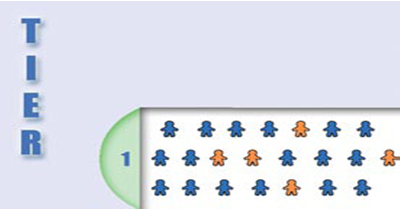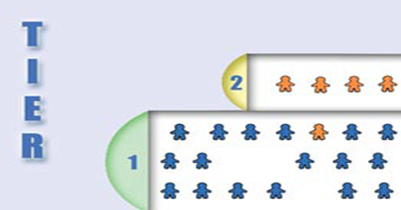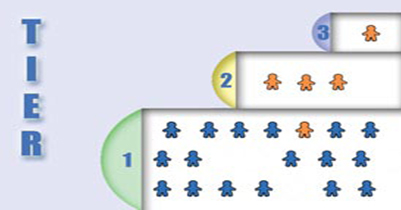A Multi-Tiered Approach
Tier 1: High-Quality Classroom Instruction, Screening, and Group Interventions
As they work with students at the school and classroom level within Tier 1, general educators working with students educated in general education classrooms are expected to ensure that they:
- Are using research-based preventive and proactive school-wide positive behavioral interventions and core instructional techniques that are geared toward:
- Making students aware of behavioral expectations;
- Encouraging, reinforcing, and acknowledging appropriate behaviors; and/or
- Meeting the behavioral and academic needs of 80% or more of the students in all settings at Tier 1.
- As they do so, these general educators are expected to ensure that they are using:
- A curriculum that is aligned with their state standards;
- Differentiated instruction designed to meet the broad range of their students’ needs; and
- A variety of assessment/screening procedures, such as:
- The number of times a teacher has requested assistance based on a student’s problem behaviors;
- How often a student has been referred for discipline purposes;
- How often a student has been distracting and/or disruptive or defiant in class;
- Curriculum-based measures;
- Weekly progress monitoring of all students;
- Teacher-made tests or progress monitoring;
- Teacher rating scales;
- Behavioral rating scales;
- Documentation of student performance, such as time on task; and/or
- Student performance on state or district-wide tests
for the purpose of continuously monitoring their students’ progress and identifying students who are at risk of failure. Such students need to be provided with:
- Additional instructional and/or classroom accommodations and modifications that may be delivered in smallgroups during the student’s regular school day in the general education classroom;
- Preferential seating;
- Positive reinforcement (points, tokens, stickers, etc.) for appropriate behaviors;
- Behavioral contracts; and/or
- A one-on-one meeting where the concern can be discussed and positive feedback provided.
The goal at this stage is to ensure general educators are providing students with good behavioral and instructional teaching in addition to regular monitoring to ensure that a majority of the students are receiving good instruction

The length of time for this step can vary, but it generally should not exceed eight weeks. During this time, the student’s progress must be closely monitored. A student who fails to show adequate progress should be moved to Tier 2.
Tier 2: - Targeted Interventions
Students who failed to make adequate progress at Tier 1 (thus about 15% of the students) have to be moved to Tier 2, where they must be provided with:
- Targeted highly efficient and rapid response instructional and positive behavioral and classroom management interventions provided by the curriculum specialist, special and related service personnel, and/or any other teachers in the building who are experts in dealing with specific problems students are experiencing. These interventions have to be provided in addition to the core behavioral and instructional interventions provided in the general education classroom at Tier 1. Such interventions can:
- Include specific tutoring and/or supplementary interventions targeted toward remediating specific academic and cognitive skills; and/or:
- Social skills instruction, such as:
- Skills streaming;
- Self-monitoring and self-management techniques and plans;
- Self-talk/attribution training (how the student thinks about him/herself and attributes behavior);
- Mentoring or peer tutoring;
- Check-in and check-out approach in which the student carries a point card from class to class and accrues points for good behavior; etc.
These interventions can:
- Be provided in small-group settings;
- Include parent-volunteer tutors; and/or
- Consist of posted visual schedules that are designed to give students picture cues needed in helping them through daily activities.
A longer period of time may be required for this tier, but it should generally not exceed 10 to 12 weeks (approximately 50 sessions). It may be advisable for educators working with students at this stage to use the Problem-Solving Model (PSM) advocated by the National Association of School Psychologists to help children who are struggling academically and behaviorally.
- The Problem Solving Model (shown as figure 3 below) includes four steps:
- Problem identification;
- Problem analysis;
- Intervention development/implementation; and
- Intervention evaluation/modification.
Figure 3: Problem Solving Model
Unlike in the Tier 1 instructional modifications or classroom accommodations, the child’s learning and/or behavioral problem is identified and interventions are designed specifically to help the struggling child learn and succeed in the problem-solving approach.

At this stage or Tier, specific students have to:
- Receive specific interventions that have been shown to help similar struggling children; while the:
- Student’s progress is carefully monitored to see if the intervention is working. If not, changes in the intervention have to be made until success is achieved.
In addition, each intervention and measurement used has to:
- Be tailored to the individual child.
The student may receive additional instruction from other teachers (e.g., reading teacher) and/or related services providers (e.g., school psychologist, speech language therapist), etc.
Those students who fail to respond to the individualized interventions provided at this stage/Tier:
- Should be referred to Tier 3 for a comprehensive assessment for the purpose of determining if the child is eligible for special education services and a possible Individualized Education Program (IEP).
Using these tiers before assessing a student for the purpose of determining if he/she needs special education service makes sense. Thus:
- In Tier 1, we know that a child who is not successful (i.e., a “non-responder”) is different from his or her classmates. If the child is a non-responder in Tier 2, we know that we tried to adapt instruction to the child and were still unsuccessful.
Tier 3: - Intensive Interventions and Comprehensive Evaluation:
Students who are still experiencing significant behavioral and academic difficulties after Tier 2 (5% of the students) should be moved to Tier 3, where they will be provided with assessment-based, highly individualized and intense instructional and positive behavioral interventions.
Those who are referred for assistance at this Tier have to be:
- Monitored using functional behavioral assessment and/or comprehensive assessment procedures;
- Provided with individualized and/or small-group (2 to 3 students) assessment-based individualized behavioral and/or instructional interventions that target the student’s skill deficits;
- Provided with cognitive behavioral therapy and/or family therapy.
- Require wrap-around services that include community services;
- Require a behavioral intervention plan; and/or
- Have an emotional or behavioral disorder.
Additionally, some may:
Those who do not:
- Achieve the desired level of progress in response to these targeted interventions are then referred for a comprehensive evaluation and considered for eligibility for special education services under the Individuals with Disabilities Education Improvement Act (IDEA 2004). The data collected during Tiers 1, 2, and 3 are included and used to make the eligibility decision.
At any point in an RTI process, IDEA allows parents to request a formal evaluation to determine eligibility for special education. An RTI process cannot be used to deny or delay a formal evaluation for special education.
